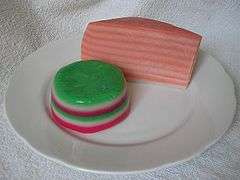Khanom chan

Khanom Chan (Thai: ขนมชั้น, pronounced [kʰānǒm t͡ɕʰán]) is one of the ancient Thai desserts, which Thai ancestors usually made for auspicious ceremonies. In Thai, the word “Khanom” (Thai: ขนม) means dessert, “Chan” (Thai: ชั้น) means layer. It is usually steamed in the complete 9 layer form. The number nine itself has connotations of prosperity in Thai culture (in Thai, 'nine' also sounds like ‘progress’). Khanom Chan therefore represents prosperity in life and promotion in your occupation.
Khanom Chan is fragrant, subtly sweet and slightly oily from the addition of coconut milk. The texture is smooth yet sticky.[1]
History
From Sukhothai period, the dealing with foreign trade with China and India have contributed to cultural exchange, for example, food. During this period Thailand has begun to develop relations with foreign countries both East and West. This made Thailand develop food that come from many nations and adapt it to suit the living conditions local people.[2]
Beliefs
Kanom Chun in the past is used in sacred ceremony such as home philanthropy, wedding, etcetera. The design of Kanom Chun has nine layers or more because number nine and beyond in Thai belief is believed to bring happiness, progress for the maker and eater. From this belief some of the local area have other name for Kanom Chun to make it more prosperous called Kanom Chun Farh(ขนมชั้นฟ้า).[3]
Ingredients in Kanom Chun
- Tapioca flour
- Talcum flour
- Rice flour
- Mung bean flour
- Sugar
- Coconut milk
- Food color or pandan juice
Difference of flour used in Kanom Chun
Tapioca flour will make Kanom Chun soft, sticky, viscous and look transparent.
Talcum flour will make Kanom Chun sticky but less transparent than tapioca flour.
Rice flour will make Kanom Chun harden and easily to hold their shape.
Mung bean flour will make Kanom Chun soft and not too sticky.
Nutritional benefits
Khanom chan consists of “Fiber” which is one of 5 groups of food that we need. Fiber is actually a complex carbohydrate, not a starch. It is a composition of plants, vegetables and fruit. It is indigestible in the stomach but it is digested by microorganism when it passes the large intestine. This process causes fiber to change into carbon dioxide, methane, hydrogen and water which can be absorbed directly into the body. The fiber can activate working process of the large intestine, make the excretory system work normally. Moreover, fiber can help to absorb carcinogen that contaminates our food and releases it out with the waste of our body. The fiber amount that we should consume is about 25-30 grams per day for our health, so we should eat Khanom chan or other Thai dessert in appropriate quantity for the good health. [4]
See also
- Thai cuisine
- List of Thai desserts
- List of Thai dishes (includes names in Thai script)
- List of Thai ingredients (includes names in Thai script)
- The Kueh lapis of Singapore is a similar dessert.
References
- ↑ Khanom Chan Ramkhamhaeng University 2003
- ↑ Junon, Nattapong. "ขนมชั้น". ประวัติขนมชั้น. Retrieved 2017-04-25.
- ↑ แจ้งชัด, กมลวรรณ (2007). ขนมไทย: เอกลักษณ์และคุณภาพ. เท็กซ์ แอนด์ เจอร์นัล พับลิเคชั่น. ISBN 9789740931607. OCLC 972726674.
- ↑ http://sinaran025.blogspot.com/2014/12/fiber-25-30-httpbankhanomdl_7.html